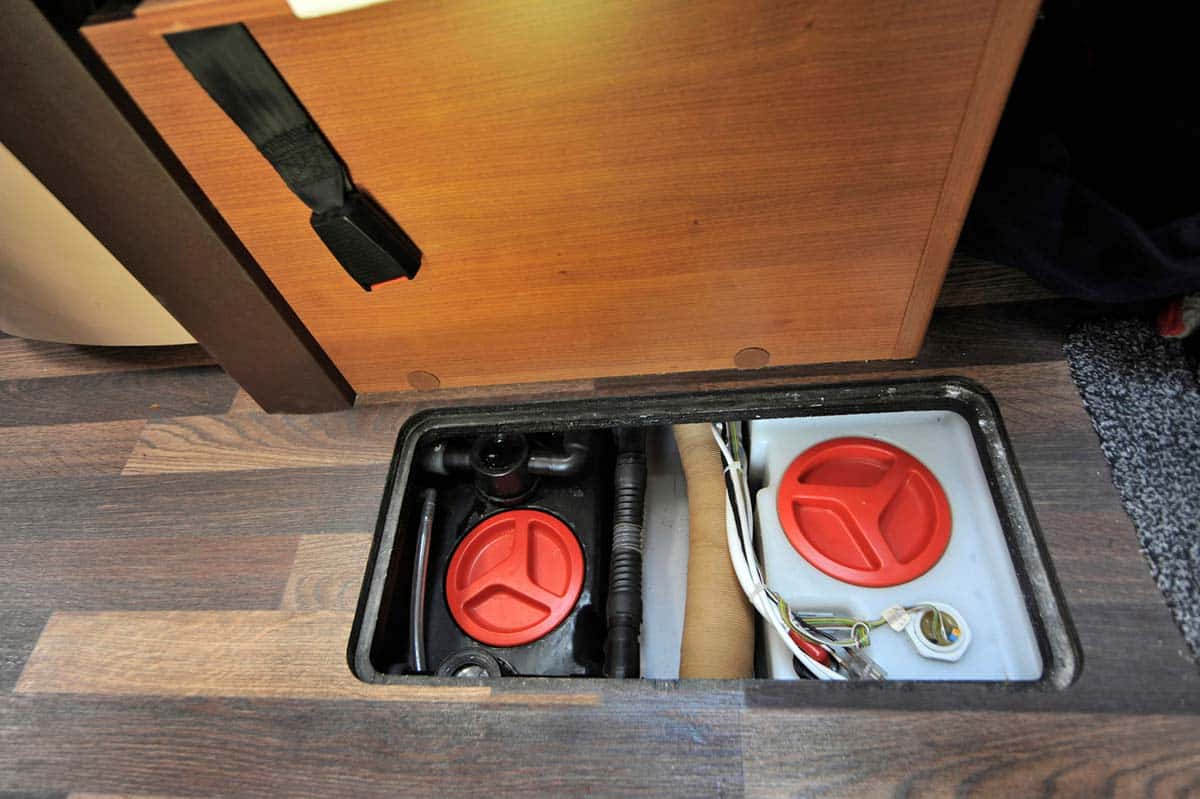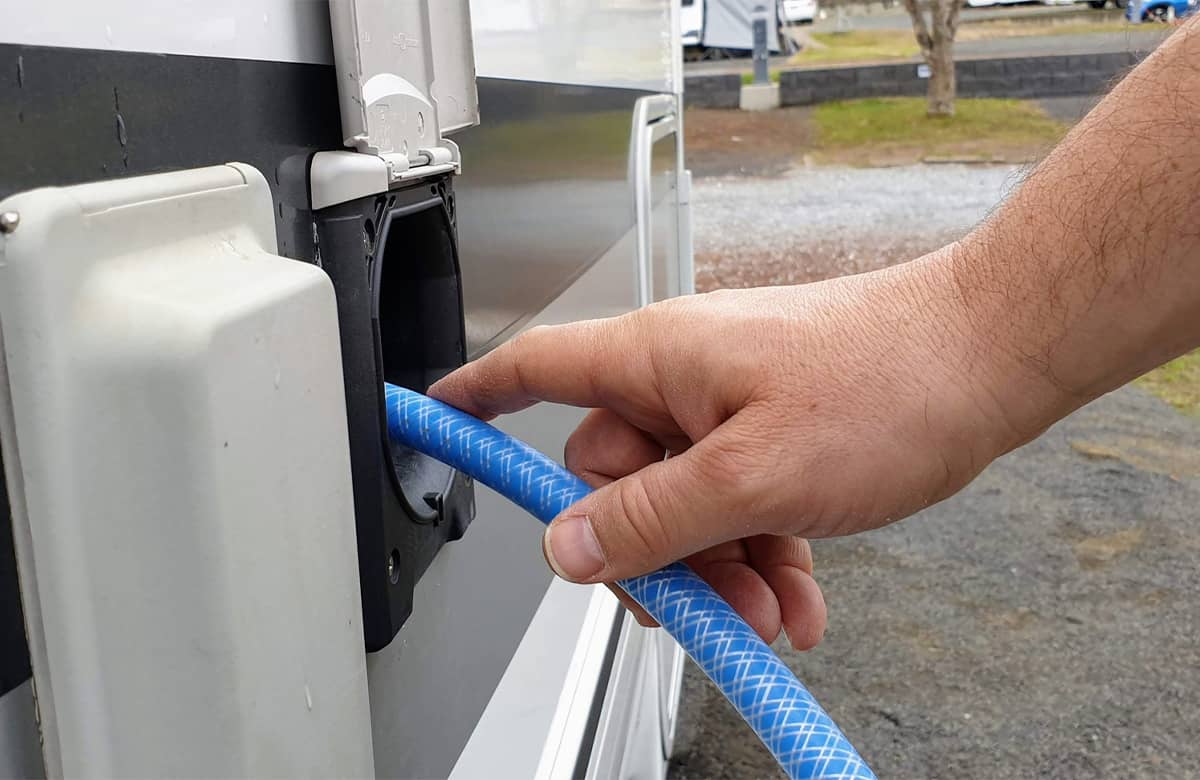Concerned about cleaning your motorhome water tank? Want to sterilise the freshwater tank on your camper or caravan? Here’s what you need to do to ensure safe drinking water in your van.
Don’t forget to grab your FREE motorhome pre-trip departure checklist below
*We work hard to make this the best motorhome travel blog and road trip website possible, full of helpful content for you. The website is supported by our readers, so if you buy through links on this site we may earn a commission- at no extra cost to you. All opinions remain our own.
If you find this post useful, you can also treat us to a coffee – we promise to enjoy it while creating more useful content like this- we might even indulge in a biscuit (or two!)
Cleaning your motorhome water tank
One thing I have always been conscious of is drinking water. Mr WB has spent a lot of time in the Middle East, where water is not always safe to drink and he’s a little obsessive about making sure we have safe water.
At least- I used to think it was obsessive until he got Legionnaire’s Disease!
Now, I should make it very clear that he did NOT get Legionnaires from our motorhome water tank, but it was from another van, which isn’t used very much.
So, to avoid the same situation in our van and help you avoid it in yours, you need to clean your motorhome freshwater tanks regularly.
Why cleaning motorhome water tanks is important
Most water carries bacteria. When that water is kept in a enclosed space (like a motorhome fresh water tank) bacteria can multiply quickly. This becomes even worse in warm temperatures. Legionella is one of the main concerns, but so is E-coli and several other types of bacteria.
Sadly, you don’t need to drink the water to become infected. If you shower from a contaminated tank, or use the water for cooking or rinsing food, you can become sick. Many of these lead to lung conditions, like pneumonia and COPD.
Also, over time, the fresh water system in your motorhome, campervan or caravan becomes contaminated by dirt, particles and even bits from the hose you use to fill up the tank. All of this promotes bacteria and makes the water less safe to consume.
You can also never guarantee that the water you’re filling your tanks up with is safe to drink either. When we were motorhoming in Scotland, we spent some time on the Isle of Skye and it turns out a sheep had died in the campsite water supply and had contaminated it all! Thank goodness we didn’t fill up!
However, many people don’t want to carry additional water for drinking, as it eats into space and payload, (1litre weighs 1kg) so keeping the water tank clean becomes a higher priority.
Is it safe to drink water from your motorhome water tank?
This is a topic which divides opinions massively. Many people only use the water straight from their tanks for showers/ cooking etc, preferring to either filter the water before drinking or boiling it for hot drinks. Here are some options for filtered water:
Others are quite happy that it’s ok to drink and don’t worry about it at all.
Personally, I do drink from the water tank as I now have an inline filter in the cold line fitted (so I don’t drink anything from the water heater!), but for many years we only used our motorhome water tank for showers, teeth cleaning and washing up and used a Lifesaver Jerrycan to drink from, even when we’re going to boil it in the kettle.
Many people ask me if the water tastes weird with the filter, but no- I can’t taste any difference tbh.
These days you can add inline water filters to your water system, although I don’t use one in my van, they are becoming popular. You can check out the Alde system here but other systems are available.
How often should you clean a motorhome water tank?
The question of how often you should clean your motorhome freshwater tank depends a lot on how often you use it and where you are. Personally, we clean ours twice a year, but that’s because we spend a lot of time touring Europe in our motorhome.
At the bare minimum you should clean it thoroughly once a year and ALWAYS when it’s been stood for a few weeks or more. This is when bacteria and biofilm can really start to grow inside the tank and make the water dangerous to drink.

How do you clean a freshwater tank on a motorhome?
The first thing to remember is that whatever you use to clean your water tank will leave a residue, which you will then be consuming for a while every time you use the water. This is why I don’t recommend a cup of bleach or bleach mixture, unless it’s either safe for human consumption or you don’t plan to ever drink from the tank again.
Then you need to pick a product. There are several on the market, and each have their pros and cons (see below).
Once chosen, here’s what you do:
- Close all taps and valves (including the hot water tank drain and relief valve)
- Add your chosen cleaning product (ie- Puriclean). Pour it into the fresh water tank directly- you might need a funnel.
- Fill system completely with fresh water from a hose or using a bucket.
- Turn on tap FURTHEST away from your fresh water tank to get the solution all through your system. Let the water run from the taps for 10-15 seconds after you hear the water pump (or until you can smell the cleaner), then close
- Leave overnight. Alternatively, you can drive around for a little while, to get the mixture into all corners. Just be aware you’re driving with a full tank and the vehicle may be heavier than you’re used to.
- Next day, fully open all taps, which allows the cleaning product to then run into your grey waste tank and clean that too. I also pour some cleaning product/ solution down the drains in the kitchen and bathroom.
- Completely empty the freshwater tank, then refill with clean water and EMPTY fully again through the taps to clean out all the pipes.
- By the end, you should not be able to smell the cleaning product any more. If you can, refill and empty again and again until the tap water no longer smells.
- It’s a good idea to change your water filters now too, so the whole system is clean and ready to go, although if you’re going into winter storage you might want to wait until the new season.
- Additionally, you can clean your grey waste tank and toilet cassette/ black water tank with the below product (BUT do not put this in your fresh water tank!):
Motorhome tank cleaning products
Like most things when it comes to cleaning your motorhome, there are several products you can choose from.
Most of them work in very similar ways, so it’s mostly a matter of choosing the product which sounds best to you.
What is Puriclean?
Puriclean is one of the most well-known motorhome tank cleaners. It’s really easy to use and works very effectively to eradicate bacteria, viruses, bio-film, algae, and fungi.
It has a dual-purpose formula which both cleans and sterilises in one go, so no need to do two treatments. It cleans the entire motorhome water system: tanks, pipes, pumps, hoses and taps and can apparently also be used to “remove stains from many domestic items such as glassware, plastic tableware, tea and coffee pots and stainless steel items such as vacuum flasks”.
One 400g tub cleans a tank of up to 270 litres and the mixture doesn’t smell, foam or harm any components in the water system. It can be tricky to know when the tank is flushed, so I would do it at least twice to remove all of the formula before you use the tank normally.
Are Aquasol and Puriclean the same thing?
NO. Aquasol and Puriclean are NOT the same things. Puriclean cleans and sterilises the tank, while Aquasol disinfects water whilst it’s in the tank waiting to be used.
We add Aquasol to our water EVERY time we fill up. It’s safe to drink or use in shower.
Can you use vinegar, bleach or acid to clean your water tank?
I’ve seen some posts and videos on Youtube talk about using citric or acetic acid to clean a motorhome water tank as it restricts the growth of bacteria and prevents algae growing.
We’ve never done this, purely because the acetic acid we know of is hazardous to eyes and skin. Many people use it as a weed killer. You can get a milder dose (vinegar is only 4% acetic acid) but I question how effective this would be!
So no, I don’t recommend using vinegar or citric acid to clean your motorhome water tank. If you do choose to, you’ll need one litre of cleaning vinegar for every 100 litres of water.
Some people also mention using bleach. Again, household bleach/ chlorine bleach can be hazardous if consumed and I don’t feel the risk is worth using it, especially when there are other products on the market which do a great job. I strongly recommend you use one of those.
If you do choose to use bleach, be aware it can damage stainless steel, which many motorhome hot water boilers are made from.
Do you need to sterilise a motorhome water tank?
Sterilising and cleaning a tank are similar, but not quite the same thing. Cleaning is more ‘washing out’, while sterilising is actively trying to kill all the bacteria.
One of the reasons we like Puriclean is it cleans AND sterilises at the same time, making the whole process much easier.
How to look after your motorhome water system while travelling
Here are some tips to keep your water tank clean while on the road:
- Change the water regularly (at least every three/four days).
- If you don’t naturally use this much water (if you’re travelling solo or naturally frugal), then just fill the tank halfway each time so it’s not standing in the tank too long.
- If you’re motorhome wild camping and want to stay off-grid , you can fill the tank full but be sure to add chemicals (we do this every time anyway, no matter whether we’re wild camping or on campsites).
- Use a proper food grade hose to fill the water tank, and keep it dedicated JUST for this task. Keep the hose in a protective bag to stop the ends coming in contact with other things. See our other motorhoming essentials here.

Can you leave your motorhome with water in it?
Water doesn’t store well, even though many plastic bottles say it will last for a few years. But stagnant water will start to get bacteria and slime very quickly- scarily quickly. I always recommend you drain your water system down unless you are using it again within a week.
I hope you found those tips useful. I know the thought of catching something nasty from your motorhome water system can be worrying, but using a proper food-grade hose and cleaning out your system and tank regularly should keep everything safe.
Want more tips for motorhoming?
Here are some more ideas you might find useful:
Want FREE checklists, eBooks and additional tips to help? Visit our resource page

Last update on 2024-07-03 / Affiliate links / Images from Amazon Product Advertising API

